Unit 1 Spring Is Coming Lesson 6 Stories about Spring 课件(15张PPT)
文档属性
| 名称 | Unit 1 Spring Is Coming Lesson 6 Stories about Spring 课件(15张PPT) | 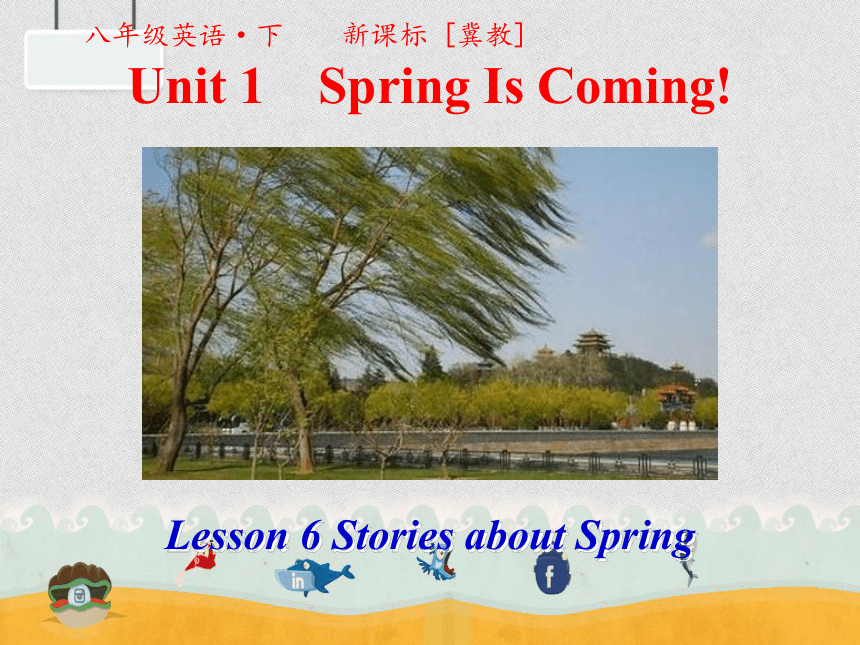 | |
| 格式 | zip | ||
| 文件大小 | 1.2MB | ||
| 资源类型 | 教案 | ||
| 版本资源 | 冀教版 | ||
| 科目 | 英语 | ||
| 更新时间 | 2019-08-17 10:07:03 | ||
图片预览

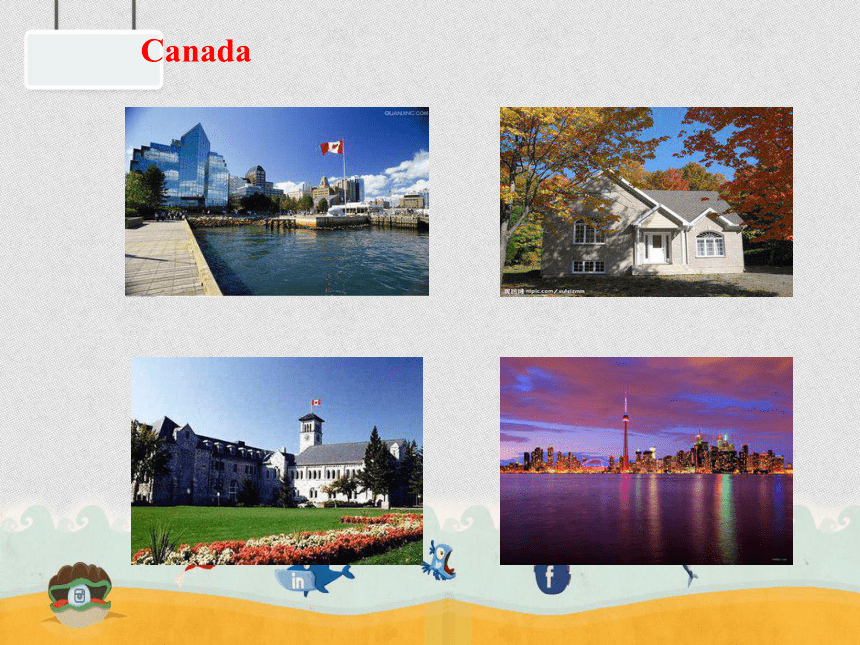
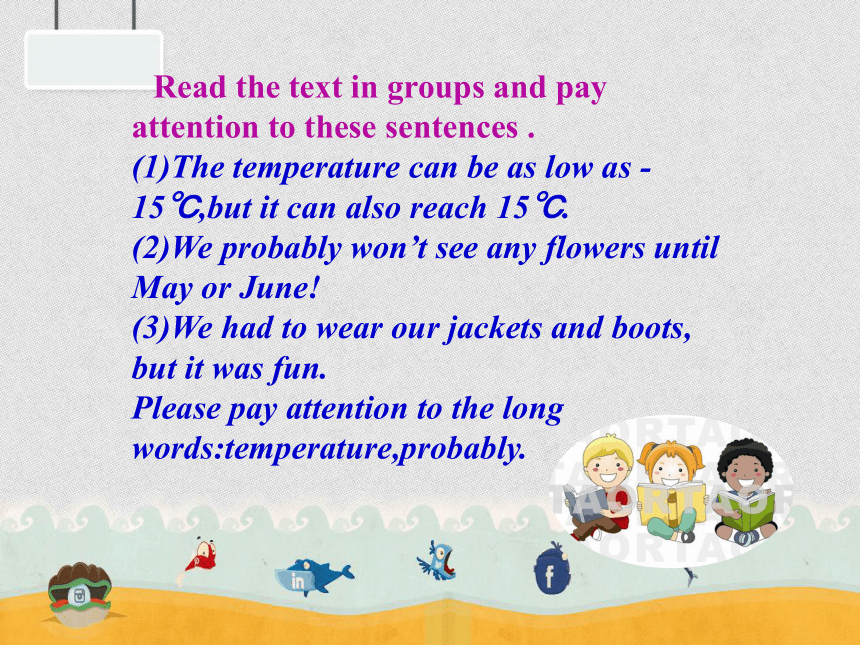

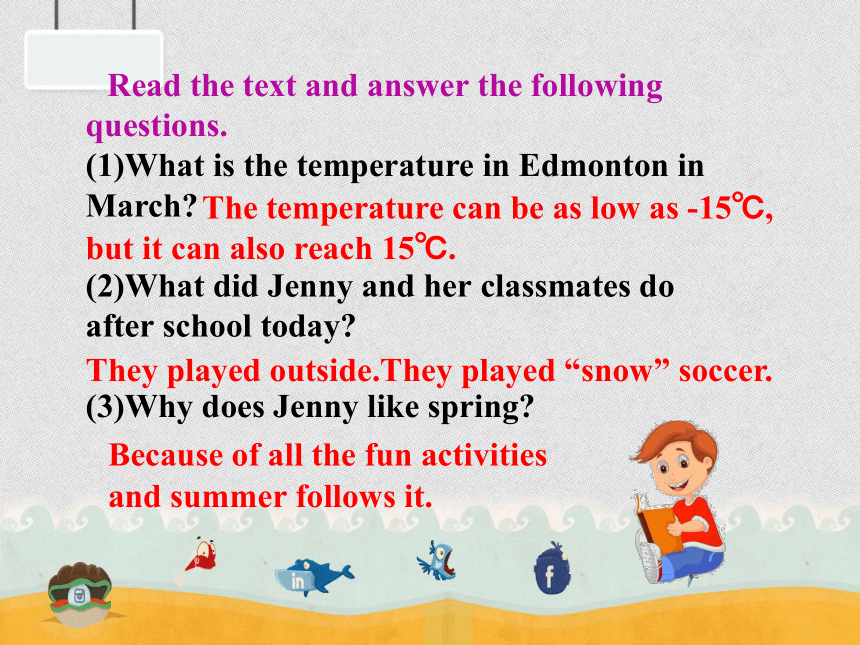
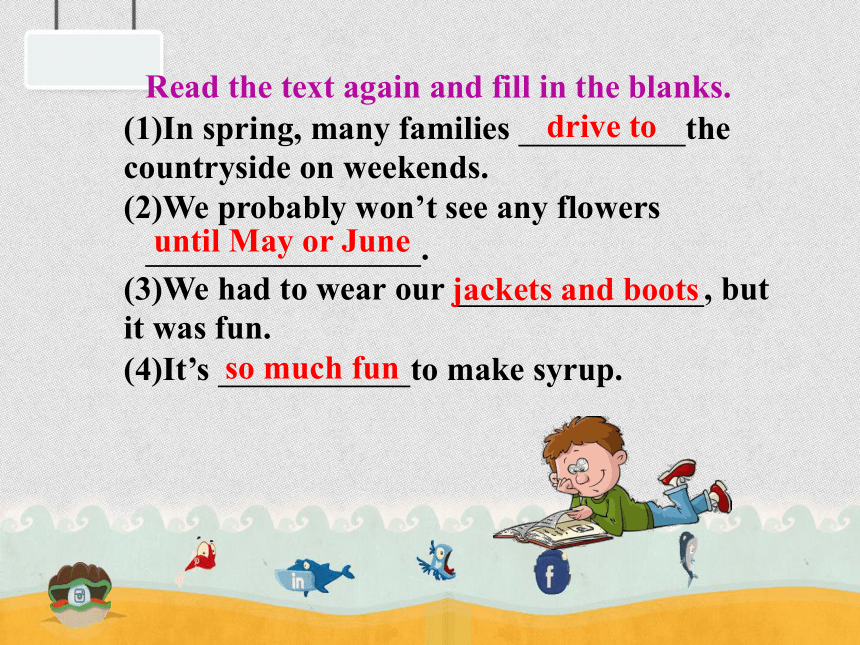
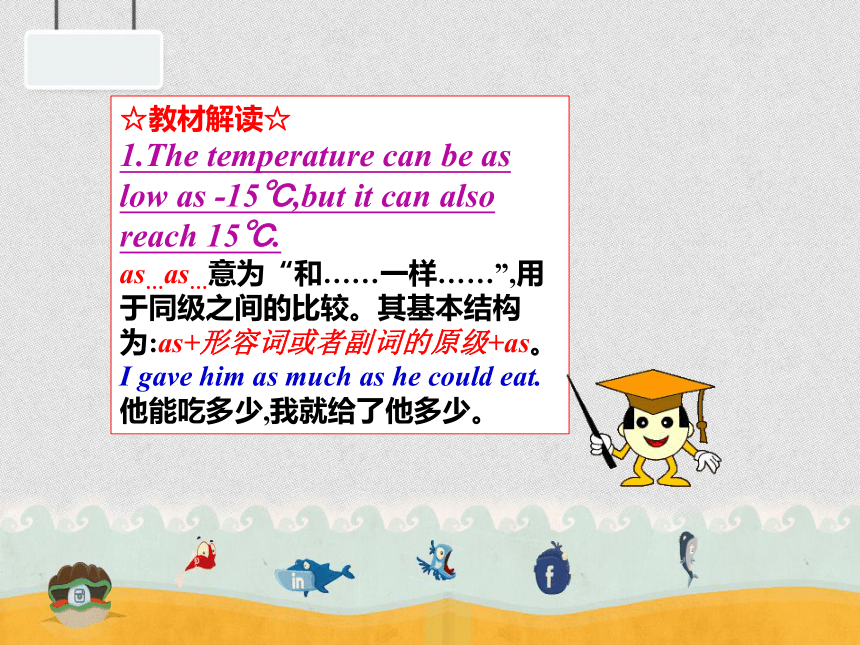
文档简介
课件15张PPT。Lesson 6 Stories about SpringUnit 1 Spring Is Coming!八年级英语·下 新课标 [冀教]CanadaRead the text in groups and pay attention to these sentences .
(1)The temperature can be as low as -15℃,but it can also reach 15℃.
(2)We probably won’t see any flowers until May or June!
(3)We had to wear our jackets and boots,
but it was fun.
Please pay attention to the long words:temperature,probably.Listen to the tape and answer the questions.
1.How is the weather in Edmonton in March?
2.When can people in Edmonton see flowers?
3.What do people in Edmonton do in spring?
It can be cold and snowy or warm and sunny.Until May or June. Many families drive to the countryside
on weekends.Read the text and answer the following questions.
(1)What is the temperature in Edmonton in March?
(2)What did Jenny and her classmates do after school today?
(3)Why does Jenny like spring?Because of all the fun activities and summer follows it. The temperature can be as low as -15℃,
but it can also reach 15℃. They played outside.They played “snow” soccer. Read the text again and fill in the blanks.
(1)In spring, many families the countryside on weekends.
(2)We probably won’t see any flowers
.
(3)We had to wear our , but it was fun.
(4)It’s to make syrup. drive tountil May or Junejackets and bootsso much fun☆教材解读☆
1.The temperature can be as low as -15℃,but it can also reach 15℃.
as…as…意为“和……一样……”,用于同级之间的比较。其基本结构为:as+形容词或者副词的原级+as。
I gave him as much as he could eat.
他能吃多少,我就给了他多少。【拓展】 (1)as…as…的否定形式为“not as/so+形容词或者副词的原级+as…”,表示“不如……,比不上……”。
(2)as…as…结构中可以使用以下修饰词(组):just,exactly,not quite,half,
twice等,并且这些修饰词(组)必须置于第一个as之前,而不能置于其后。 2.We probably won’t see any flowers until May or June!
until意为“直到……为止”,引导时间状语从句。until用于肯定句时,主句的动作必须是延续性的,表示这一动作或状态一直延续到until所表示的时间为止;用于否定句时,主句的动作一般是非延续性动词,强调表示动作或者状态直到until所表示的时间才发生,构成not…until…结构,表示“直到……才……”。如果主句使用一般将来时态,则从句必须用一般现在时态表示将来。
The bus won’t start until everyone gets on.直到每个人都上车,公共汽车才会开动。【拓展】 till 是连词,意思是“直到……之时;在……之前”,通常用来表示时间,相当于until,只是语气较弱。
They waited here till ten o’clock.他们在这儿一直等到十点。3.We had to wear our jackets and boots,but it was fun.
had to是have to的过去式,意为“不得不”,后接动词原形。
We have to stay at home.
我们不得不待在家里。 【辨析】 have to,must
have to与 must均有“必须”的意思,但must强调人主观认为必须做某事,而have to强调客观情况迫使人不得不做某事;且must只用于一般现在时中,没有人称和数的变化,而have to可用于多种时态中,并且有人称和数的变化。
We must go to school on time.
我们必须按时上学。
She has to look after her baby at home.她不得不在家照顾孩子。4.Spring is a time to look forward to flowers and fresh food from the garden.
look forward to意为“盼望;期待”,其中to 是介词,后接名词、代词或者动名词。
I’m looking forward to visiting the Great Wall.我盼望着去游览长城。Look at the sentences with some missing words.Please use proper words to fill them.
1.The temperature is so l that we have to wear warm clothes.
2.Children of four and b can go to the zoo for free.
3.Water turns into ice at z degrees Celsius.
4.I didn’t go to bed u my parents come back.
5.It has so much f to make syrup.
owelowerontilunHomework
1.Practice the letter with your group members after class.
2.Copy the new words twice.
(1)The temperature can be as low as -15℃,but it can also reach 15℃.
(2)We probably won’t see any flowers until May or June!
(3)We had to wear our jackets and boots,
but it was fun.
Please pay attention to the long words:temperature,probably.Listen to the tape and answer the questions.
1.How is the weather in Edmonton in March?
2.When can people in Edmonton see flowers?
3.What do people in Edmonton do in spring?
It can be cold and snowy or warm and sunny.Until May or June. Many families drive to the countryside
on weekends.Read the text and answer the following questions.
(1)What is the temperature in Edmonton in March?
(2)What did Jenny and her classmates do after school today?
(3)Why does Jenny like spring?Because of all the fun activities and summer follows it. The temperature can be as low as -15℃,
but it can also reach 15℃. They played outside.They played “snow” soccer. Read the text again and fill in the blanks.
(1)In spring, many families the countryside on weekends.
(2)We probably won’t see any flowers
.
(3)We had to wear our , but it was fun.
(4)It’s to make syrup. drive tountil May or Junejackets and bootsso much fun☆教材解读☆
1.The temperature can be as low as -15℃,but it can also reach 15℃.
as…as…意为“和……一样……”,用于同级之间的比较。其基本结构为:as+形容词或者副词的原级+as。
I gave him as much as he could eat.
他能吃多少,我就给了他多少。【拓展】 (1)as…as…的否定形式为“not as/so+形容词或者副词的原级+as…”,表示“不如……,比不上……”。
(2)as…as…结构中可以使用以下修饰词(组):just,exactly,not quite,half,
twice等,并且这些修饰词(组)必须置于第一个as之前,而不能置于其后。 2.We probably won’t see any flowers until May or June!
until意为“直到……为止”,引导时间状语从句。until用于肯定句时,主句的动作必须是延续性的,表示这一动作或状态一直延续到until所表示的时间为止;用于否定句时,主句的动作一般是非延续性动词,强调表示动作或者状态直到until所表示的时间才发生,构成not…until…结构,表示“直到……才……”。如果主句使用一般将来时态,则从句必须用一般现在时态表示将来。
The bus won’t start until everyone gets on.直到每个人都上车,公共汽车才会开动。【拓展】 till 是连词,意思是“直到……之时;在……之前”,通常用来表示时间,相当于until,只是语气较弱。
They waited here till ten o’clock.他们在这儿一直等到十点。3.We had to wear our jackets and boots,but it was fun.
had to是have to的过去式,意为“不得不”,后接动词原形。
We have to stay at home.
我们不得不待在家里。 【辨析】 have to,must
have to与 must均有“必须”的意思,但must强调人主观认为必须做某事,而have to强调客观情况迫使人不得不做某事;且must只用于一般现在时中,没有人称和数的变化,而have to可用于多种时态中,并且有人称和数的变化。
We must go to school on time.
我们必须按时上学。
She has to look after her baby at home.她不得不在家照顾孩子。4.Spring is a time to look forward to flowers and fresh food from the garden.
look forward to意为“盼望;期待”,其中to 是介词,后接名词、代词或者动名词。
I’m looking forward to visiting the Great Wall.我盼望着去游览长城。Look at the sentences with some missing words.Please use proper words to fill them.
1.The temperature is so l that we have to wear warm clothes.
2.Children of four and b can go to the zoo for free.
3.Water turns into ice at z degrees Celsius.
4.I didn’t go to bed u my parents come back.
5.It has so much f to make syrup.
owelowerontilunHomework
1.Practice the letter with your group members after class.
2.Copy the new words twice.
同课章节目录
- Unit 1 Spring Is Coming
- Lesson 1 How's the weather?
- Lesson 2 It's Getting Warmer!
- Lesson 3 Sun Is Rising
- Lesson 4 The Spring City
- Lesson 5 Babysitting on a Spring Day
- Lesson 6 Stories about Spring
- Unit 2 Plant a Plant
- Lesson 7 Planting Trees
- Lesson 8 Why Are Plants Important?
- Lesson 9 Gardening with Mary
- Lesson 10 Make Your Garden Grow!
- Lesson 11 Amazing Plants
- Lesson 12 Danny's Plant
- Unit 3 Animals Are Our Friends
- Lesson 13 Danny's Big Scare
- Lesson 14 Amazing Animals
- Lesson 15 The Zoo Is Open
- Lesson 16 The Pear Escaped
- Lesson 17 Save the Tigers
- Lesson 18 Friendship Between Animals
- Unit 4 The Internet Connects Us
- Lesson 19 How Do You Use the Internet?
- Lesson 20 A Computer Helps!
- Lesson 21 Books or Computers?
- Lesson 22 Travel on the Internet
- Lesson 23 The Internet--Good or Bad?
- Lesson 24 An E-mail to Grandpa
- Unit 5 Buying and Selling
- Lesson 25 Raising Money
- Lesson 26 Cookies, Please!
- Lesson 27 Business English
- Lesson 28 Ms. Liu's Great Idea
- Lesson 29 How to Push a Product
- Lesson 30 A Cookie Sale
- Unit 6 Be a Champion!
- Lesson 31 Don't Fall, Danny
- Lesson 32 My Favourite Record
- Lesson 33 2800 Years of Sports
- Lesson 34 Modern Olympics
- Lesson 35 The Dream Team
- Lesson 36 Classroom Olympics
- Unit 7 Know Our World
- Lesson 37 Let's Learn Geography!
- Lesson 38 The World Is a Big Place
- Lesson 39 Ring Up or Call?
- Lesson 40 Body Language
- Lesson 41 A Class of the World
- Lesson 42 North America
- Unit 8 Save Our World
- Lesson 43 Let's Clean Up!
- Lesson 44 Environment Clubs
- Lesson 45 Let's Sort Garbage!
- Lesson 46 Protect Our Environment
- Lesson 47 Connected to Nature
- Lesson 48 Garbage Is Interesting!
